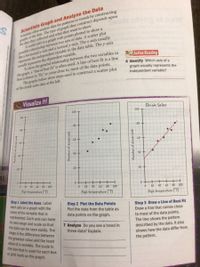
MATLAB: An Introduction with Applications
6th Edition
ISBN: 9781119256830
Author: Amos Gilat
Publisher: John Wiley & Sons Inc
expand_more
expand_more
format_list_bulleted
Question
Please help

Transcribed Image Text:Scientists Graph and Analyze the Data
Scientists often analyze data for patterns or trends by constructing
graphs of the data. The type of graph they construct depends upon
the data they collected and what they want to show.
A scatter plot is a graph with points plotted to show a
possible relationship between two sets of data. A scatter plot
has a horizontal xr-axis and a vertical y-axis. The x-axis usually
represents the independent variable in the data table. The y-axis
usually represents the dependent variable.
To show the general relationship between the two variables in
the graph, a "line of best fit" is often used. A line of best fit is a line
that is drawn to "fit," or come close to, most of the data points.
The graphs below show steps used to construct a scatter plot
Active Reading
6 Identify Which axis of a
graph usually represents the
independent variable?
of the drink sales data at the left.
OVisualize It!
Drink Sales
100
100
80-
80 +
80
60
60
60 +
40
40
20
20
20
0 20 40 GO 80 100
High temperature (° F)
0.
20
40
60 80 100
20
40 60 80 100
High temperature (°F)
High temperature (°F)
Step 1 Label the Axes Label
each axis on a graph with the
name of the variable that is
Step 2 Plot the Data Points
Plot the data from the table as
Step 3 Draw a Line of Best Fit
Draw a line that comes close
represented. Each axis can have
data points on the graph.
to most of the data points.
The line shows the pattern
its own range and scale so that
the data can be seen easily. The
range is the difference between
the greatest value and the least
value of a variable. The scale is
the size that is used for each box
or grid mark on the graph.
7 Analyze Do you see a trend in
these data? Explain.
described by the data. It also
shows how the data differ from
the pattern.
Number of drinks sold
Number of drinks sold
Expert Solution
This question has been solved!
Explore an expertly crafted, step-by-step solution for a thorough understanding of key concepts.
This is a popular solution
Trending nowThis is a popular solution!
Step by stepSolved in 3 steps

Knowledge Booster
Similar questions
arrow_back_ios
arrow_forward_ios
Recommended textbooks for you
 MATLAB: An Introduction with ApplicationsStatisticsISBN:9781119256830Author:Amos GilatPublisher:John Wiley & Sons Inc
MATLAB: An Introduction with ApplicationsStatisticsISBN:9781119256830Author:Amos GilatPublisher:John Wiley & Sons Inc Probability and Statistics for Engineering and th...StatisticsISBN:9781305251809Author:Jay L. DevorePublisher:Cengage Learning
Probability and Statistics for Engineering and th...StatisticsISBN:9781305251809Author:Jay L. DevorePublisher:Cengage Learning Statistics for The Behavioral Sciences (MindTap C...StatisticsISBN:9781305504912Author:Frederick J Gravetter, Larry B. WallnauPublisher:Cengage Learning
Statistics for The Behavioral Sciences (MindTap C...StatisticsISBN:9781305504912Author:Frederick J Gravetter, Larry B. WallnauPublisher:Cengage Learning Elementary Statistics: Picturing the World (7th E...StatisticsISBN:9780134683416Author:Ron Larson, Betsy FarberPublisher:PEARSON
Elementary Statistics: Picturing the World (7th E...StatisticsISBN:9780134683416Author:Ron Larson, Betsy FarberPublisher:PEARSON The Basic Practice of StatisticsStatisticsISBN:9781319042578Author:David S. Moore, William I. Notz, Michael A. FlignerPublisher:W. H. Freeman
The Basic Practice of StatisticsStatisticsISBN:9781319042578Author:David S. Moore, William I. Notz, Michael A. FlignerPublisher:W. H. Freeman Introduction to the Practice of StatisticsStatisticsISBN:9781319013387Author:David S. Moore, George P. McCabe, Bruce A. CraigPublisher:W. H. Freeman
Introduction to the Practice of StatisticsStatisticsISBN:9781319013387Author:David S. Moore, George P. McCabe, Bruce A. CraigPublisher:W. H. Freeman

MATLAB: An Introduction with Applications
Statistics
ISBN:9781119256830
Author:Amos Gilat
Publisher:John Wiley & Sons Inc

Probability and Statistics for Engineering and th...
Statistics
ISBN:9781305251809
Author:Jay L. Devore
Publisher:Cengage Learning

Statistics for The Behavioral Sciences (MindTap C...
Statistics
ISBN:9781305504912
Author:Frederick J Gravetter, Larry B. Wallnau
Publisher:Cengage Learning

Elementary Statistics: Picturing the World (7th E...
Statistics
ISBN:9780134683416
Author:Ron Larson, Betsy Farber
Publisher:PEARSON

The Basic Practice of Statistics
Statistics
ISBN:9781319042578
Author:David S. Moore, William I. Notz, Michael A. Fligner
Publisher:W. H. Freeman

Introduction to the Practice of Statistics
Statistics
ISBN:9781319013387
Author:David S. Moore, George P. McCabe, Bruce A. Craig
Publisher:W. H. Freeman